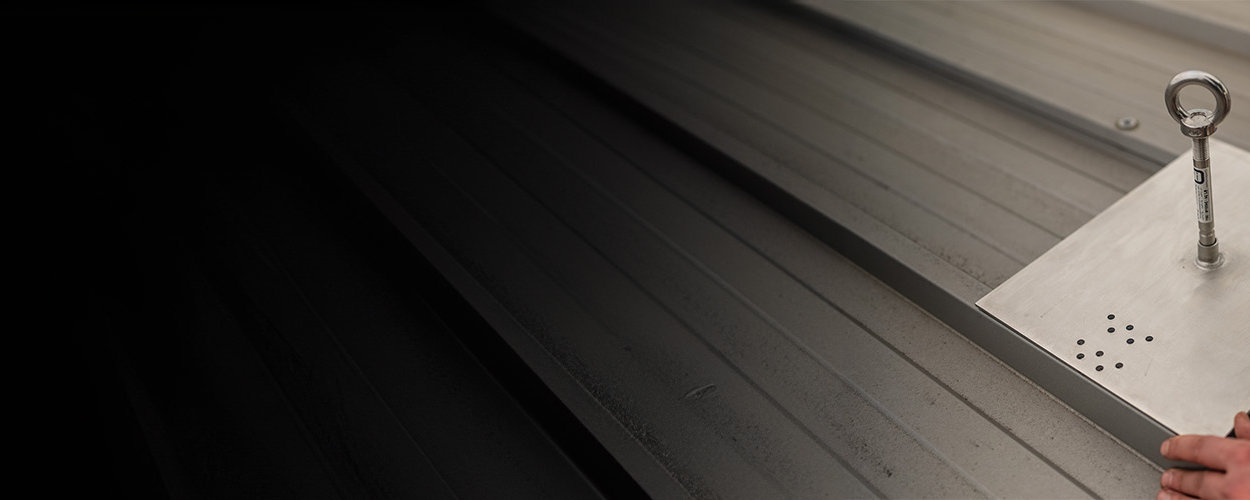What are roof hooks?
Roof hooks are special fastening elements that are used for fall protection on pitched roofs. These hooks are attached to the roof structure and serve as anchor points for personal fall protection equipment (PPE), such as lifeline systems or safety harnesses. Thanks to their design, they provide effective protection for one person and are comparable to anchor points on flat roofs.
Regulations
To ensure safety on roofs, it is essential that safety roof hooks are carefully planned and installed in accordance with DGUV 201-056 and DIN 4426. These anchorage devices play a crucial role in fall protection on construction sites and must therefore comply with strict specifications and standards.
According to the regulations, safety roof hooks may only be installed and used on pitched roofs with a maximum pitch of 75°. This ensures that the hooks are stable and safe and can provide reliable protection. To ensure their functionality and safety, it is crucial that they are regularly maintained.
In addition to complying with the regulations and standards mentioned, it is important that the safety roof hooks are produced, tested and labeled in accordance with the DIN EN 517 standard. This standard sets out strict requirements for the safety and quality of roof hooks to ensure that they meet the highest standards and provide reliable protection.
Roof hooks: use and function
Roof hooks are versatile aids that are used as fall protection on pitched roofs and fulfill the following main functions:
- Primary function: Roof hooks are primarily used as anchor points for personal protective equipment (PPE) against falls from a height.
- Application: They are attached to the roof structure and thus provide a secure attachment point for lifeline systems, safety harnesses or height safety harnesses.
- Load capacity: Roof hooks are available in various designs and offer load capacities of up to 6 kN (approx. 600 kg) depending on the model.
- Material: Roof hooks are usually made of malleable steel to absorb the forces that occur during a fall and subsequent securing.
- Webbing energy absorber: In combination with a webbing energy absorber, the forces acting on the user during a fall can be significantly reduced.
How are roof hooks installed?
Safety roof hooks are designed in such a way that they are usually mounted on a wooden substrate using screws (usually between 130 mm and 160 mm long). A plank in the shape of an H is mounted on two beams. The roof hook can be attached to the plank, which now forms the connecting element between the two joists, using screws. Our Primo 30 BOK safety roof hook, for example, can be successfully installed in this way.
In order to guarantee the highest level of safety, the manufacturer's installation instructions should be strictly followed.
Are there alternative mounting options?
There are alternatives to mounting on a plank. For example, roof hooks can also be mounted on rafters. Another option is to replace the wooden plank with a metal rail or a wooden board. However, you must use the appropriate roof hook for this - because roof hooks are not universally usable and approved for all installation variants.
What are the differences between the various roof hook variants?
Roof hooks can be differentiated not only in terms of their type of installation. Another important distinction is made by DIN EN 517. This divides roof hooks into two types: Type A roof hooks and type B roof hooks
Type A and B roof hooks - the differences
Type A safety roof hooks were only tested with regard to one direction of fall. To be able to use type A safety roof hooks, the roof hooks must therefore always be above the user to be secured. This can unnecessarily complicate access to the roof, for example from a window.
Overall, mobility is severely restricted compared to the use of type B. If you want to use type A on your pitched roof, you should plan well so that all areas can be reached later. The planning effort for type B, on the other hand, is negligible.
Material used
In order to meet as many individual requirements as possible, we also offer safety roof hooks in several material versions. Our range includes roof hooks made entirely of stainless steel as well as galvanized. Our Primo 33 Uni is also available in a complete stainless steel/galvanized rail version.
